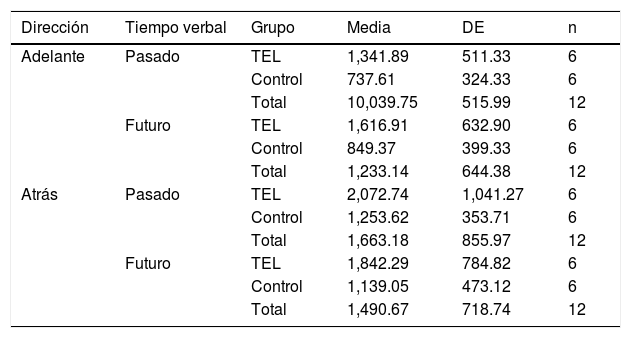Evaluar si los niños con trastorno del desarrollo lingüístico de tipo mixto (TDL) comprenden el tiempo verbal por medio de la metáfora conceptual «tiempo es espacio» (futuro adelante, pasado atrás).
MétodoSe elaboró un experimento de plasticidad inducida que consistió en mover fichas de un recipiente a otro realizando un movimiento adelante o atrás, y luego realizar un juicio de coherencia semántica en oraciones en pasado y futuro.
ResultadosEl desempeño general de los niños con TDL fue inferior en comparación con los niños con desarrollo típico (DT), con menos aciertos en las oraciones en pasado que en futuro. La interacción entre los dominios conceptuales de la metáfora (dirección del movimiento y tiempo verbal) al medir el tiempo de respuesta evidenció un efecto de interferencia compatible con la metáfora en niños con TDL y con DT. Al medir el porcentaje de aciertos, los resultados arrojaron una interacción entre dirección, tiempo y grupo, que muestra un efecto de facilitación compatible con la metáfora en los niños con TDL y un efecto de interferencia en niños con DT. Todos los resultados dependieron de la covariable atención sostenida.
ConclusionesEsta investigación da cuenta de la relación que existe entre el dominio espacial del eje adelante-atrás y la comprensión del tiempo verbal en niños con TDL y niños con normodesarrollo lingüístico. Los resultados se explican por medio de la teoría de la metáfora conceptual y las teorías corpóreas, y son de relevancia para futuras investigaciones y nuevas propuestas de intervención en el TDL.
To assess whether children with mixed developmental language disorders (DLD) understand verb tense through the conceptual metaphor «time is space» (future ahead, past behind).
MethodAn induced plasticity experiment was used which comprised moving tokens from one container to another using a forward or backward movement, and then forming a judgement of semantic coherence in past and future sentences.
ResultsThe overall performance of the children with DLD was lower compared to typically developing (TD) children, attaining fewer hits in past sentences than future sentences. The interaction between the conceptual domains of the metaphor (movement direction and verb tense) when measuring response time, showed an interference effect compatible with the metaphor in the DLD and the TD children. When measuring the hit rate, the results showed an interaction between direction, tense, and group, showing a facilitation effect compatible with the metaphor in the children with DLD and an interference effect in the TD children. All the results depended on sustained attention.
ConclusionsThis research study shows the relationship between the spatial dominance of the forward/backward axis and understanding of verb tense in children with DLD and children with normal language development. The results are explained through the theory of conceptual metaphor and corporeal theories and are relevant for future research and new proposals for intervention in DLD.
Artículo
Comprando el artículo el PDF del mismo podrá ser descargado
Precio 19,34 €
Comprar ahora














